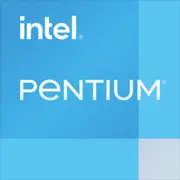Intel Pentium N3710

Intel Pentium N3710: A Budget Processor for Basic Tasks in 2025
April 2025
Despite the rapidly evolving processor market, there remains a demand for ultra-budget laptops for simple tasks even in 2025. The Intel Pentium N3710 is one such chip that, despite its age (the Braswell architecture debuted in 2015), is still found in new entry-level devices. Let's explore who this processor is suitable for and what to consider when choosing a laptop with it.
Architecture and Process Technology: Modest Capabilities for Basic Needs
The Pentium N3710 is built on the Braswell microarchitecture and manufactured using a 14nm process technology. It is a 4-core CPU without Hyper-Threading support, meaning it has 4 threads. The base clock frequency is 1.6 GHz, with a maximum turbo frequency reaching 2.56 GHz. However, due to its low TDP (6W), stable operation at high frequencies is not possible—under load, the processor quickly reaches its thermal limit.
Integrated graphics are provided by Intel HD Graphics 405 (12 EU, 400–700 MHz). It supports 4K video decoding via HDMI 1.4 but lacks enough power for gaming or video editing.
Key Architectural Features:
- No AVX instruction support, limiting performance in professional applications.
- Maximum RAM support of 8GB DDR3L-1600.
- No support for Thunderbolt or USB 3.1 Gen 2—only USB 3.0 and SATA III.
Power Consumption and TDP: Quiet Operation and Compactness
With a TDP of 6W, passive cooling can be utilized, making laptops with the N3710 completely silent. This is ideal for devices where mobility is important: for example, thin Chromebooks (ASUS Chromebook C423) or hybrid tablets (Lenovo IdeaPad Flex 3).
However, the low TDP has a downside: under prolonged load (for instance, opening 20 browser tabs), the processor reduces its frequency to the base 1.6 GHz to avoid overheating.
Performance: Realistic Expectations
Geekbench 6:
- Single-Core: 190;
- Multi-Core: 273.
These results are comparable to mid-range modern smartphones (like Snapdragon 7 Gen 2) but are modest for laptops.
Office Work:
- Google Docs documents and Excel spreadsheets with moderately complex formulas—work without issues.
- Simultaneous use of 5-7 tabs in Chrome + messengers—possible slowdowns.
Multimedia:
- Playback of 1080p/4K video (H.264/H.265)—smooth, thanks to Intel Clear Video decoder.
- Photo editing in Lightroom—only basic edits (cropping, brightness).
Gaming:
- 2020s games: only 2D platformers (Hollow Knight) or older titles (Half-Life 2) on low settings (720p, 20–30 FPS).
Turbo Boost Mode:
A brief “burst” up to 2.56 GHz helps with short tasks—opening applications, loading web pages. However, it is useless for rendering or gaming.
Usage Scenarios: Who is the N3710 Suitable For
1. Students—for lectures, text work, and Zoom.
2. Minimalist Users—surfing, online banking, YouTube.
3. Travel Devices—compact laptops with battery life of 8–10 hours (e.g., Acer Aspire 1).
Not Suitable For:
- Gamers—even Minecraft on medium settings will lag.
- Designers/engineers—Photoshop or AutoCAD will not run.
Battery Life: Up to 10 Hours Unplugged
Thanks to its 6W TDP and energy-efficient cores, laptops with the N3710 demonstrate impressive battery life:
- 8–10 hours when working with documents (50% brightness, Wi-Fi on).
- 6–7 hours during video streaming (Netflix, YouTube).
Power-Saving Technologies:
- Intel SpeedStep—dynamic frequency adjustment.
- Panel Self Refresh—reducing GPU load with static images.
Tip: For maximum battery life, choose models with a battery capacity of at least 40 Wh (e.g., HP Stream 14).
Comparison with Competitors
AMD A6-9220e (2019):
- 2 cores, 6W TDP, Radeon R4 Graphics.
- Falls short in multi-threaded tasks but performs better in gaming (by 10-15%).
Intel Celeron N4500 (2021):
- 2 cores, 10nm process, UHD Graphics.
- Better performance in single-thread tests (Geekbench 6 Single-Core—240), but price is 20% higher.
Apple M1 (2020):
- An indirect competitor, but by 2025 even a used MacBook Air M1 will cost $400–500 compared to $200–300 for the N3710.
Pros and Cons
Strengths:
- Low price of laptops ($200–300).
- Silent operation (no fan).
- Long battery life.
Weaknesses:
- Weak multi-tasking capabilities.
- No support for modern interfaces (USB-C with PD, Wi-Fi 6).
- Limited lifespan (morally outdated by 2025).
Recommendations for Choosing a Laptop
1. Type of Device: ultrabook or Chromebook with a size of 11–14 inches (e.g., Lenovo IdeaPad Slim 3).
2. RAM: at least 4GB, preferably 8GB (DDR3L).
3. Storage: definitely SSD (even 128GB), as HDD will slow down the system.
4. Screen: IPS matrix with a resolution of 1920×1080. Avoid TN panels.
5. Ports: check for USB 3.0 and HDMI for monitor connections.
Examples of 2025 Models:
- ASUS VivoBook L403 ($249): 14" IPS, 4GB RAM, 128GB SSD.
- Dell Inspiron 15 3525 ($279): 15.6" HD, 8GB RAM, 256GB SSD.
Final Conclusion
The Intel Pentium N3710 is a choice for those who need the cheapest laptop for basic tasks. Its advantages, including price, silent operation, and battery life, outweigh its disadvantages if you do not plan to run “heavy” applications.
Who is it for:
- Users with a budget up to $300.
- Those who value portability (device weight—1.2–1.5 kg).
- Need a second laptop for travel.
Alternative: If your budget allows adding $100–150, consider laptops with Intel Celeron N4500 or AMD Athlon Silver 3050U—they will last longer.
In 2025, the N3710 remains a niche solution, but it is still relevant for its intended tasks. The key is to clearly understand what you are getting for your money.
Basic
CPU Specifications
Memory Specifications
GPU Specifications
Miscellaneous
Benchmarks
Compared to Other CPU
Share in social media
Or Link To Us
<a href="https://cputronic.com/cpu/intel-pentium-n3710" target="_blank">Intel Pentium N3710</a>